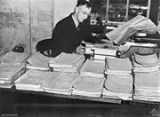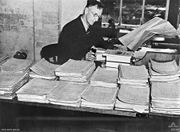
Official History of Australia in the War of 1914-1918
Encyclopedia
The Official History of Australia in the War of 1914-1918 is a 12-volume series covering Australia
n involvement in the First World War
. The series was edited by C.E.W. Bean
, who also wrote six of the volumes, and was published between 1920 and 1942. The first seven volumes deal with the Australian Imperial Force while other volumes deal with the Australian Naval and Military Expeditionary Force
at Rabaul
, the Royal Australian Navy
, the Australian Flying Corps and the home front
. The final volume is a photographic record.
Unlike other official histories which are often aimed at military staff, Bean intended the Australian history to be accessible to a non-military audience. The relatively small size of Australia's forces enabled the history to be presented in great detail, giving accounts of individual actions that would not have been possible when covering a larger force. For example, Bean dedicated over 100 pages to the Battle of Fromelles
, a relatively small action intended as a diversion during the Battle of the Somme that lasted one night and involved a single Australian division (the 5th). However, Fromelles was also the first time that the First Australian Imperial Force
(AIF) saw action on the Western Front
, and was very costly for the Australians, with 5,533 killed, wounded or captured.
Following the publication of the final volume, Charles Bean compiled Anzac to Amiens, a condensed history in a single volume aimed at the general public, which was published in 1946.

Australia
Australia , officially the Commonwealth of Australia, is a country in the Southern Hemisphere comprising the mainland of the Australian continent, the island of Tasmania, and numerous smaller islands in the Indian and Pacific Oceans. It is the world's sixth-largest country by total area...
n involvement in the First World War
World War I
World War I , which was predominantly called the World War or the Great War from its occurrence until 1939, and the First World War or World War I thereafter, was a major war centred in Europe that began on 28 July 1914 and lasted until 11 November 1918...
. The series was edited by C.E.W. Bean
Charles Bean
Charles Edwin Woodrow Bean , usually identified as C.E.W. Bean, was an Australian schoolmaster, judge's associate, barrister journalist, war correspondent and historian....
, who also wrote six of the volumes, and was published between 1920 and 1942. The first seven volumes deal with the Australian Imperial Force while other volumes deal with the Australian Naval and Military Expeditionary Force
Australian Naval and Military Expeditionary Force
The Australian Naval and Military Expeditionary Force was a small volunteer force of approximately 2,000 men, raised in Australia shortly after the outbreak of the First World War to seize and destroy German wireless stations in German New Guinea in the south-west Pacific...
at Rabaul
Rabaul
Rabaul is a township in East New Britain province, Papua New Guinea. The town was the provincial capital and most important settlement in the province until it was destroyed in 1994 by falling ash of a volcanic eruption. During the eruption, ash was sent thousands of metres into the air and the...
, the Royal Australian Navy
Royal Australian Navy
The Royal Australian Navy is the naval branch of the Australian Defence Force. Following the Federation of Australia in 1901, the ships and resources of the separate colonial navies were integrated into a national force: the Commonwealth Naval Forces...
, the Australian Flying Corps and the home front
Home front
Home front is the informal term commonly used to describe the civilian populace of the nation at war as an active support system of their military....
. The final volume is a photographic record.
Unlike other official histories which are often aimed at military staff, Bean intended the Australian history to be accessible to a non-military audience. The relatively small size of Australia's forces enabled the history to be presented in great detail, giving accounts of individual actions that would not have been possible when covering a larger force. For example, Bean dedicated over 100 pages to the Battle of Fromelles
Battle of Fromelles
The Battle of Fromelles, sometimes known as the Action at Fromelles or the Battle of Fleurbaix , occurred in France between 19 July and 20 July 1916, during World War I...
, a relatively small action intended as a diversion during the Battle of the Somme that lasted one night and involved a single Australian division (the 5th). However, Fromelles was also the first time that the First Australian Imperial Force
First Australian Imperial Force
The First Australian Imperial Force was the main expeditionary force of the Australian Army during World War I. It was formed from 15 August 1914, following Britain's declaration of war on Germany. Generally known at the time as the AIF, it is today referred to as the 1st AIF to distinguish from...
(AIF) saw action on the Western Front
Western Front (World War I)
Following the outbreak of World War I in 1914, the German Army opened the Western Front by first invading Luxembourg and Belgium, then gaining military control of important industrial regions in France. The tide of the advance was dramatically turned with the Battle of the Marne...
, and was very costly for the Australians, with 5,533 killed, wounded or captured.
Following the publication of the final volume, Charles Bean compiled Anzac to Amiens, a condensed history in a single volume aimed at the general public, which was published in 1946.
Volumes

- Volume I - The Story of Anzac: the first phase, C.E.W Bean, 1921
- Volume II - The Story of Anzac: from 4 May, 1915 to the evacuation, C.E.W Bean, 1924
- Volume III - The Australian Imperial Force in France: 1916, C.E.W Bean, 1929
- Volume IV - The Australian Imperial Force in France: 1917, C.E.W Bean, 1933
- Volume V - The Australian Imperial Force in France: December 1917 - May 1918, C.E.W Bean, 1937
- Volume VI - The Australian Imperial Force in France: May 1918 - the Armistice, C.E.W Bean, 1942
- Volume VII - The Australian Imperial Force in Sinai and Palestine: 1914 - 1918, H.S. GullettHenry GullettSir Henry Somer Gullett KCMG was an Australian Cabinet Minister and member of the House of RepresentativesGullett was born at Toolamba West, Victoria and educated at state schools, but left school at twelve on the death of his father. He began writing for newspapers...
, 1923 - Volume VIII - The Australian Flying Corps: 1914 - 1918, F.M. Cutlack, 1923
- Volume IX - The Royal Australian Navy: 1914 - 1918, Arthur W. JoseArthur Wilberforce JoseArthur Wilberforce Jose was an English-Australian historian and editor of the Australian Encyclopaedia.Jose was born at Bristol, South West England, eldest son of William Wilberforce Jose, , and his wife Sarah Maria, née Woodward. W. W...
, 1928 - Volume X - The Australians at Rabaul, S.S. Mackenzie, 1927
- Volume XI - Australia during the War, Ernest Scott, 1936
- Volume XII - Photographic Record of the War
Other volumes
The following volumes are: 'Official History of the Australian Army Medical Services, 1914–1918' also considered to be Volumes XIII, XIV & XV of the Official History.- Volume I – Gallipoli, Palestine and New Guinea (2nd edition, 1938)
- Volume II – The Western Front (1st edition, 1940)
- Volume III – Special Problems and Services (1st edition, 1943)
See also
- History of the Great WarHistory of the Great WarThe History of the Great War is a series of 28 volumes covering the military operations of the British Army during the First World War. The full title is the History of the Great War Based on Official Documents but the series is usually referred to as the British Official History...
- 29-volume British official history edited by Brigadier-General Sir James EdmondsJames Edward EdmondsBrigadier General James Edward Edmonds CB, CMG was a British First World War officer of the Royal Engineers who in the role of British official historian was responsible for the post-war compilation of the 28-volume History of the Great War...
.

